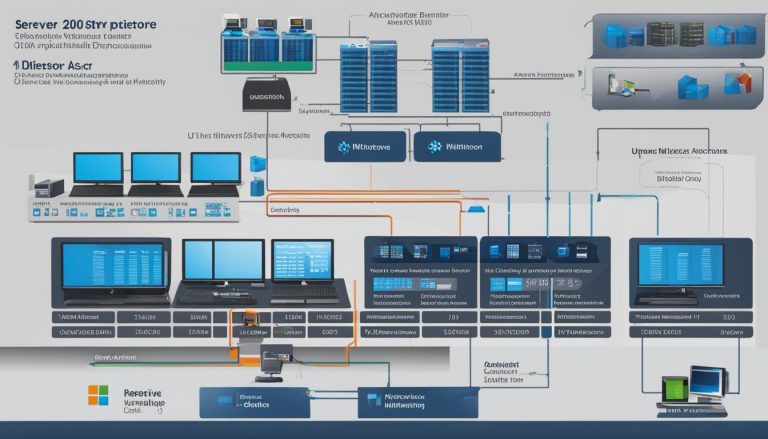Welcome to my comprehensive guide on Windows NT 4.0 Server. In this article, we will explore the key aspects of this operating system developed by Microsoft in 1993. Let’s dive in and discover what makes Windows NT 4.0 Server a noteworthy milestone in the evolution of server operating systems.
Windows NT 4.0 Server was an advanced family of operating systems that introduced groundbreaking capabilities for its time. With support for multiprocessing, multiple users, and processor independence, it offered unparalleled flexibility and performance. This article will provide you with an overview of its features, drawbacks, and its significance in the history of server operating systems.
Key Takeaways:
- Windows NT 4.0 Server was a revolutionary operating system developed by Microsoft in 1993.
- It introduced advanced capabilities such as multiprocessing and support for multiple users.
- Windows NT 4.0 Server had two products: Windows NT Workstation and Windows NT Server.
- Key features included a 32-bit version of Windows, support for multiple CPUs, and compatibility with various hardware platforms.
- While it had some drawbacks, Windows NT 4.0 Server laid the foundation for the evolution of the Windows Server OS.
Key Features of Windows NT 4.0 Server
Windows NT 4.0 Server introduced several key features that set it apart from its predecessors. One of the most significant advancements was the 32-bit version of the operating system, which provided improved performance and compatibility with modern applications. This allowed users to take advantage of the latest software developments and run resource-intensive applications with ease.
Another notable feature was the support for multiple CPU systems with symmetric multiprocessing (SMP). This meant that Windows NT 4.0 Server could leverage the power of multiple processors, enabling faster and more efficient data processing. This was especially beneficial for high-demand applications and environments that required significant computational capabilities.
Windows NT 4.0 Server also boasted compatibility with various hardware platforms, offering flexibility and choice to users. Whether it was running on Intel x86, Alpha, MIPS, or PowerPC processors, the operating system provided a consistent and reliable experience across different machines. This made it a popular choice in diverse computing environments.
| Key Features | Benefits |
|---|---|
| 32-bit architecture | Improved performance and compatibility with modern applications |
| Support for symmetric multiprocessing (SMP) | Enhanced data processing and performance for high-demand applications |
| Compatibility with various hardware platforms | Flexibility and choice for diverse computing environments |
| Pre-emptive multitasking | Efficient management of multiple processes and improved system responsiveness |
| Support for multiple protocols (TCP/IP, NetBEUI) | Seamless connectivity and networking capabilities |
In addition to these features, Windows NT 4.0 Server offered pre-emptive multitasking, allowing for efficient management of multiple processes and improved system responsiveness. This ensured that the operating system could handle concurrent tasks effectively, optimizing performance for users.
Lastly, Windows NT 4.0 Server supported multiple protocols, including TCP/IP and NetBEUI. This enabled seamless connectivity and networking capabilities, making it easier to connect to clients and perform heavy network-related tasks without restrictions.
Evolution of Windows NT
Windows NT has a rich history that dates back to its initial development in 1988. Initially, it was a collaborative effort between Microsoft and IBM, with the goal of creating a high-performance, secure operating system. However, the partnership between the two companies didn’t last, and Microsoft decided to change the primary API for the unreleased NT OS/2, leading to a separation.
Windows NT was designed to be portable, running on multiple instruction set architectures and supporting various hardware platforms. This flexibility allowed it to cater to different needs and environments. Over the years, Microsoft released several versions of the Windows Server OS, each with its own set of improvements and features.
From Windows NT 3.1 Advanced Server to Windows NT Server 4.0, each release brought enhancements to networking capabilities, compatibility with non-Microsoft machines, and improved performance. These updates aimed to address the evolving needs of businesses and ensure that Windows NT remained a reliable choice for server operating systems.
Windows Server OS Versions:
| Version | Year | Key Features |
|---|---|---|
| Windows NT 3.1 Advanced Server | 1993 | First release of Windows NT Server |
| Windows NT 3.5 Server | 1994 | Improved networking capabilities |
| Windows NT Server 3.51 | 1995 | Compatibility with non-Microsoft machines |
| Windows NT Server 4.0 | 1996 | Enhanced performance and support for symmetric multiprocessing |
As evident from the table, each version of the Windows Server OS introduced new features and enhancements. Windows NT 4.0 Server, in particular, marked a significant milestone with its 32-bit architecture and robust support for symmetric multiprocessing. These advancements laid the groundwork for the subsequent evolution of the Windows Server OS family.
Windows NT’s evolution demonstrates Microsoft’s commitment to continuously improving and adapting their server operating systems to meet the needs of businesses and technological advancements. While Windows NT 4.0 Server is no longer supported, newer versions, such as Windows Server 2022, offer advanced security features, improved performance, and enhanced support for modern hardware and applications.
Windows NT 4.0 Server Drawbacks
Despite its popularity and advanced capabilities, Windows NT 4.0 Server had a few drawbacks that users encountered. One significant limitation was its lack of compatibility with UNIX programming APIs. This meant that developers had to rewrite or modify their applications to work with Windows NT 4.0 Server, which could be time-consuming and costly. Additionally, the operating system faced performance issues on systems with slower processors and limited memory, making it less efficient for resource-intensive tasks.
Another drawback of Windows NT 4.0 Server was its performance with certain applications on RISC processors. Due to data structure alignment issues, these applications experienced reduced performance, making it challenging for users relying on RISC-based systems to fully leverage the benefits of the operating system.
Despite these limitations, Windows NT 4.0 Server still had many strengths that made it a popular choice for organizations during its time. Its performance, application service capability, and support for a wide range of software applications were highly regarded. However, as technology advanced and newer versions of the Windows Server OS became available, organizations began migrating to take advantage of improved security, performance, and better support for modern hardware and applications.
Windows NT Server 4.0 and Windows Server 2022
Windows NT Server 4.0, although outdated, was once a popular operating system known for its performance and application service capabilities. However, as technology has advanced, Microsoft no longer supports this version. Organizations that are still using Windows NT Server 4.0 are advised to consider migrating to a newer and more advanced version, such as Windows Server 2022.
Migrating to Windows Server 2022 brings numerous benefits, including enhanced security features, improved performance, and better support for modern hardware and applications. With the ever-evolving threats in today’s digital landscape, it is crucial for organizations to ensure their systems are protected by using the latest security measures offered by the latest Windows Server version.
The migration process from Windows NT Server 4.0 to Windows Server 2022 may require careful planning and consideration. Compatibility with existing applications should be thoroughly assessed to ensure a smooth transition. Some legacy applications may require additional configuration or may not be compatible with the newer version. Therefore, it is crucial to identify and address any potential issues before initiating the migration process.
| Windows NT Server 4.0 | Windows Server 2022 |
|---|---|
| Outdated and no longer supported by Microsoft | Continuously supported and regularly updated by Microsoft |
| Limited security features | Advanced security features |
| Compatibility issues with modern hardware and applications | Better support for modern hardware and applications |
| Performance limitations on older hardware | Improved performance on modern hardware |
By migrating from Windows NT Server 4.0 to Windows Server 2022, organizations can future-proof their systems and take advantage of the latest advancements in server technology. It is important to work closely with IT professionals or consult with Microsoft to ensure a successful and seamless migration process, mitigating any potential risks and maximizing the benefits of the newer operating system.
Windows NT 4.0 Server Timeline
The Windows NT 4.0 Server timeline provides an overview of the various releases and updates of this significant operating system developed by Microsoft in the early 1990s. Let’s take a closer look at the evolution of Windows NT 4.0 Server and its key milestones.
Windows NT 3.1 Advanced Server (1993)
The journey of Windows NT 4.0 Server begins with its initial release as Windows NT 3.1 Advanced Server in 1993. This version introduced significant advancements, including support for multiple CPU systems with symmetric multiprocessing and compatibility with various hardware platforms. It laid the foundation for future releases and showcased Microsoft’s commitment to delivering a powerful, enterprise-level operating system.
Windows NT 3.5 Server and Windows NT Server 3.51
Following the initial release, Microsoft continued to enhance the Windows NT Server family. Windows NT 3.5 Server and Windows NT Server 3.51 brought improvements such as enhanced networking capabilities and compatibility with non-Microsoft machines. These updates further solidified Windows NT 4.0 Server’s reputation as a reliable and versatile operating system.
Windows NT Server 4.0 (1996)
In 1996, Microsoft released the highly anticipated Windows NT Server 4.0. This version marked a significant milestone in the evolution of the Windows Server OS, introducing a 32-bit architecture and support for symmetric multiprocessing. Windows NT Server 4.0 offered enhanced performance, advanced networking capabilities, and improved compatibility with a wide range of software applications.
Throughout its timeline, Windows NT 4.0 Server underwent several updates and iterations, each bringing new features and improvements. From its early beginnings as Windows NT 3.1 Advanced Server to its final release as Windows NT Server 4.0, this operating system played a crucial role in shaping the future of Windows Server OS.
Table: Windows NT 4.0 Server Releases
| Release Name | Release Year | Notable Features |
|---|---|---|
| Windows NT 3.1 Advanced Server | 1993 | Support for multiple CPU systems with symmetric multiprocessing, compatibility with various hardware platforms |
| Windows NT 3.5 Server | 1994 | Enhanced networking capabilities, compatibility with non-Microsoft machines |
| Windows NT Server 3.51 | 1995 | Improved compatibility and networking features |
| Windows NT Server 4.0 | 1996 | 32-bit architecture, support for symmetric multiprocessing, enhanced performance |
This table highlights the major releases of Windows NT 4.0 Server along with their notable features. It provides a comprehensive overview of the evolution and progression of this influential operating system.
Conclusion
Windows NT 4.0 Server was a significant operating system developed by Microsoft in the early 1990s. It offered advanced features for its time and served as the foundation for the evolution of the Windows Server OS.
While Windows NT 4.0 Server is no longer supported by Microsoft, organizations can benefit from migrating to newer versions of the Windows Server OS. Upgrading to newer versions, such as Windows Server 2022, provides enhanced security, improved performance, and better support for modern hardware and applications.
However, migrating from Windows NT 4.0 Server to Windows Server 2022 may require careful planning and consideration of application compatibility. Organizations should assess their specific needs and resources to ensure a successful transition.
Overall, Windows NT 4.0 Server played a crucial role in the development of server operating systems. Its legacy lives on in the advancements of the Windows Server OS, offering organizations a more secure, efficient, and reliable platform to meet their evolving needs.
FAQ
What is Windows NT 4.0 Server?
Windows NT 4.0 Server was a family of operating systems developed by Microsoft in 1993. It featured advanced capabilities for the time, including multiprocessing, support for multiple users, and processor independence. It offered both software and hardware portability and was released for various processor architectures.
What were the key features of Windows NT 4.0 Server?
Windows NT 4.0 Server introduced several key features, including a 32-bit version of Windows, support for multiple CPU systems with symmetric multiprocessing, compatibility with various hardware platforms, pre-emptive multitasking, and support for multiple protocols such as TCP/IP and NetBEUI. The NTFS file system included advanced multiuser and security features, and Windows NT 4.0 Server had the ability to connect to clients without restrictions for heavy network-related tasks.
How did Windows NT evolve over time?
Development of Windows NT started in 1988 as a collaboration between Microsoft and IBM. However, Microsoft decided to change the primary API for the unreleased NT OS/2, leading to a separation between the two companies. Windows NT was designed to run on multiple instruction set architectures and support multiple hardware platforms. Over the years, Microsoft released several versions of the Windows Server OS, each with its own set of improvements and features.
What were the drawbacks of Windows NT 4.0 Server?
While Windows NT 4.0 Server was popular for its performance, application service capability, and support for various software applications, it had a few drawbacks. It was generally not compatible with UNIX in terms of programming APIs, and it had performance issues on systems with slower processors and limited memory. Additionally, it created performance issues with certain applications on RISC processors due to data structure alignment issues.
What is the current status of Windows NT 4.0 Server?
Windows NT Server 4.0 is an outdated operating system that is no longer supported by Microsoft. Organizations using Windows NT 4.0 Server are encouraged to migrate to newer versions, such as Windows Server 2022, which offers advanced security features, improved performance, and better support for modern hardware and applications. Migrating from Windows NT 4.0 Server to Windows Server 2022 may require careful planning and consideration of application compatibility.
What is the timeline of Windows NT 4.0 Server?
The Windows NT 4.0 Server timeline begins with its initial release in 1993 as Windows NT 3.1 Advanced Server. Over the years, Microsoft released several updates and versions, including Windows NT 3.5 Server, Windows NT Server 3.51, and Windows NT Server 4.0. Each release introduced new features and improvements, such as enhanced networking capabilities and compatibility with non-Microsoft machines. Windows NT 4.0 Server featured a 32-bit architecture and support for symmetric multiprocessing.
Janina is a senior specialist in information technology


